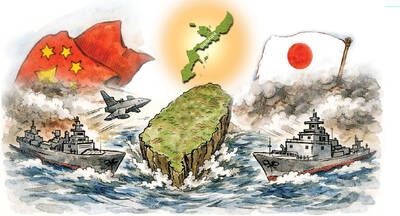Simplicity comes first at Faust Pizza Lounge (明月光). Opened last month on Renai Road (仁愛路), across from Sun Yat-sen Memorial Hall (國父紀念館), the pizzeria sells only two things: pizza and beer. The restaurant’s laid-back, charming ambiance and its reasonable prices stand in stark contrast to its competition in the upscale Xinyi neighborhood, where ritzy shopping complexes loom nearby.
Between an indoor dining area and outdoor seating lies an open kitchen where the chef tosses circles of dough up in the air and into the large brick oven, allowing the aroma of baking pies to emanate throughout the establishment.
The interior design is casual and minimalist. Who needs fancy cutlery and hip design with unpretentious, hearty fare that’s this good?
At Faust Pizza Lounge, meals come in the form of nine types of thin-crust, 12 inch pizzas and four flavors of German brew Faust.
My dining group has already visited the establishment a few times and tried almost every available option on the menu.
“Light” and “grease-free” are the words that pop up in conversations about the restaurant’s pizza. Those hoping for a heart-attack inducing
grease-pit of a pizza may be disappointed.
But fans of stone-oven baked pizza will be pleased to know that the thin crust of the pizza is always done just right — satisfyingly crispy on the sides and slightly charred on the bottom.
Diners looking for something more savory can try the Roma (salami, onion, mushroom and olives, NT$220) or the Frankfurter Sausage (sausage, bacon and basil, NT$220). Pizza staples such as the Margarita (NT$180) and Hawaiian (NT$220) are popular items
as well, while vegetarian
options include the Funghi
(king oyster mushrooms, tomato, Italian capers and chilies, NT$260) and the Veggie (tomato, mushroom, olives and green pepper, NT$220).
The three fresh-out-of-college proprietors act as the restaurant’s chefs and handle their business with aplomb.
Any review of Faust Pizza Lounge would be remiss not to mention the public relation work carried out by the owners’ five-year-old poodle, impeccably groomed and well-mannered, who never fails to elicit remarks of admiration from patrons.
Faust offers takeaway but no delivery service. Make sure to give the chef plenty of time to make your pies since the pizzeria is usually packed on both weekends and weekday evenings.

Most heroes are remembered for the battles they fought. Taiwan’s Black Bat Squadron is remembered for flying into Chinese airspace 838 times between 1953 and 1967, and for the 148 men whose sacrifice bought the intelligence that kept Taiwan secure. Two-thirds of the squadron died carrying out missions most people wouldn’t learn about for another 40 years. The squadron lost 15 aircraft and 148 crew members over those 14 years, making it the deadliest unit in Taiwan’s military history by casualty rate. They flew at night, often at low altitudes, straight into some of the most heavily defended airspace in Asia.

Taiwan’s democracy is at risk. Be very alarmed. This is not a drill. The current constitutional crisis progressed slowly, then suddenly. Political tensions, partisan hostility and emotions are all running high right when cool heads and calm negotiation are most needed. Oxford defines brinkmanship as: “The art or practice of pursuing a dangerous policy to the limits of safety before stopping, especially in politics.” It says the term comes from a quote from a 1956 Cold War interview with then-American Secretary of State John Foster Dulles, when he said: ‘The ability to get to the verge without getting into the war is

Beijing’s ironic, abusive tantrums aimed at Japan since Japanese Prime Minister Sanae Takaichi publicly stated that a Taiwan contingency would be an existential crisis for Japan, have revealed for all the world to see that the People’s Republic of China (PRC) lusts after Okinawa. We all owe Takaichi a debt of thanks for getting the PRC to make that public. The PRC and its netizens, taking their cue from the Chinese Communist Party (CCP), are presenting Okinawa by mirroring the claims about Taiwan. Official PRC propaganda organs began to wax lyrical about Okinawa’s “unsettled status” beginning last month. A Global

Like much in the world today, theater has experienced major disruptions over the six years since COVID-19. The pandemic, the war in Ukraine and social media have created a new normal of geopolitical and information uncertainty, and the performing arts are not immune to these effects. “Ten years ago people wanted to come to the theater to engage with important issues, but now the Internet allows them to engage with those issues powerfully and immediately,” said Faith Tan, programming director of the Esplanade in Singapore, speaking last week in Japan. “One reaction to unpredictability has been a renewed emphasis on